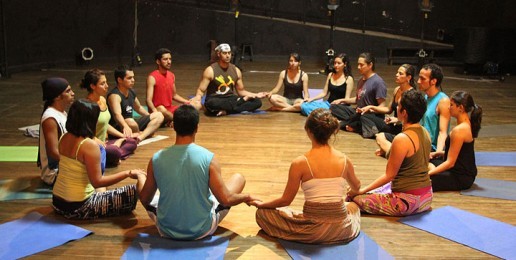
by Claris Van Kuiken
This summer, classes in Kundalini Yoga have been made available through the New Lenox Community Park District to members of the growing Illinois community. The ad in the park district’s brochure assures the participant that through the use of movement, sound current, breath and meditation, Kundalini Yoga “brings a greater feeling of well-being and happiness” and can “heal your mind and body.” While the mission of the New Lenox park district Board of Trustees is to provide “safe recreational opportunities” for residents, the ad does not make one aware of the potential physical, mental and spiritual dangers many yoga instructors warn about.
Such a promise of healing carries great responsibility and necessarily raises a few questions. What is Kundalini Yoga? Where did it come from? Why is it used? What are the risks involved? Who is the instructor?
Yoga is an ancient Hindu/occult spiritual discipline that can be traced back to the Indo-European people who lived in India during the 2nd millennium, B.C. Their religion was Vedism, which evolved into Hinduism. The Vedic sages have been credited for the development of yoga. The practice can be found in the Upanishads, which comprise the last part of the oldest religious Indian writings recorded, the Vedas, and in the Hindu favorite, the Bhagavad Gita, composed by the revered sage, Vyasa. These writings are claimed to have been “channeled” by the sages who were considered “seers,” god-men with super-human powers capable of dematerializing and shape-shifting. It’s assumed that masters of yoga possess occult powers such as telepathy, ESP, clairvoyance, levitation, and mediumistic abilities.
Hinduism made a splash in the United States at the 1893 World Parliament of Religions held in Chicago, IL where Swami Vivekananda extolled its virtues as he called for the religions of the world to unite under its philosophy. In the 1920’s, the Theosophical Society, co-founded by the famed Russian occultist, Helena P. Blavastky, based its headquarters in Wheaton, IL making a combination of Hinduism and other occult/mystical Eastern religious literature more available to Westerners.
During the 60’s and 70’s, a surge of gurus (men claiming to be gods) traveled from India to America on a mission to convert the West to Hinduism. Along with its companion, Transcendental Meditation, taught by the Maharishi Mahesh Yogi, yoga was quickly sold to Westerners as a great way to reduce stress, build self-esteem, heal the mind and body, and experience the interconnectedness of all creation.
Gurus know yoga is much more than a physical exercise. Those unaware of the spiritual nature of yoga, however, have often been subtly initiated into Eastern/occultic mysticism. Over a period of time, their world-view begins to change, and gradually, a different view of who God is, begins to emerge. As former Indian guru Rabi Maharaj explained, “There is no Hinduism without Yoga and there is no Yoga without Hinduism.”
The Sanskrit word for yoga is “yuj,” meaning “union.” It’s through the practice of yoga that Hindus believe they can experience their own divinity (called Self-realization or God-realization) as they unite with Brahman – the universal, divine, energy force found within all creation they call “God.” Our problem, complains the guru, is that we forgot who we are. Yoga is the path used to remembering, and eventually becoming, our Higher Self (god), breaking a continuous cycle of karma (cause & effect) and reincarnation (deaths & rebirths).
So what is Kundalini Yoga? Often associated with Tantra Yoga, Kundalini Yoga is considered the fast way to enlightenment (becoming “god”). Laura Kalinski, yoga instructor for the New Lenox Park District, follows the teachings of the now deceased guru, Yogi Bhajan, who considered Kundalini Yoga a Raj Yoga (a royal path), because it combines all the traditional “eight limbs” of yoga together. The eight limbs are: moral restraint, self restraint through study and devotion to “God,” postures, breath control, sensory inhibition, concentration – “fixing one’s attention upon a selected object, whether a mantra or graphic representation of a deity,” meditation – a “deepening of concentration marked by a progressive unification of consciousness,” and finally, ecstasy – “one’s complete merging with the object of meditation” (Tantra, The Path of Ecstasy, Georg Feuerstein, Shambala Pub., Inc., Boston, MA. 1998, pg. 124).
Kundalini (Sanskrit-kund), means “coiled” or “serpent” and represents divine, psychic energy called “serpent power.” It is seen in the form of a coiled, female snake (the goddess aspect of the Divine) nestled at the base of the spine. For Hindus, who worship over 300 million gods, the aim of Kundalini Yoga is to reunite the goddess Shakti with her lover, Lord Shiva, god of destruction and creation, bringing about a state of bliss and enlightenment. This is the “bliss” the yoga practitioner is said to experience after raising the kundalini energy through seven chakras (energy centres) located from the base of the spine up the spinal column to the crown chakra, the top of the head. Psychic powers are purportedly acquired when a person opens their sixth chakra, the third eye-just above the middle of the eyebrows.
The body and hand positions (asanas & mudras) performed during yoga also have significance behind them. For example, the Cobra asana is taken from the movement of the snake which is revered in India. The Eagle asana is used to focus on the sixth chakra, helping one to attain psychic/occult powers. The Garuda mudra, “mystical bird,” is used to enable communication with the spirit world. The Mantangi mudra represents the Hindu Goddess of Peace, and so forth.
Instructors use “sound current” in the form of mantras–chants said repeatedly to bring about a “higher” state of consciousness. The Adi mantra, Ong Namo Guru Dev Namo, is chanted a number of times to “tune in” oneself at the beginning of each Kundalini Yoga class. Ong Namo means, I bow to the subtle divine wisdom. Guru De Namo means, I bow to the Divine or Infinite Teacher within. Yogi Bhajan taught, “God is your inner consciousness.” In a real sense, you are worshiping yourself. Chanting mantras are said to have penetrating power in the Cosmos connecting you to the deceased Bhajan and past Master Teachers in what is called The Golden Chain, providing divine guidance to the practitioner.
The chanting of mantras, breathing techniques, deep concentration and meditation in Kundalini Yoga brings one into an altered state of consciousness. This is a form of self-hypnosis, the roots of which lie in the occult.
The American Society of Clinical Hypnosis lists over fifty possible dangers from hypnosis in their American Journal of Clinical Hypnosis (Volume 31, Number 1, July 1988, pg. 46). It’s no coincidence that many listed are the same risks yoga instructors warn about. Dangers of these practices include: severe headaches, depression, uncontrolled weeping or laughter, spasmodic jerking, feelings of intense heat or cold, electricity passing through the body and itching or crawling sensations, memory impairment, hallucinations, identity crisis, mental illness/insanity, suicidal thoughts/suicide, anxiety/panic attacks, heart palpitations, heart attack and death. On the other hand, one may experience intense feelings of a beautiful oneness with the universe, infinite love, and ecstatic bliss.
In his book, The Awakening of Kundalini,” Gopi Krishna warned that prana (energy or life-force), can lead to blissful experiences, but if it isn’t “properly attuned” can lead to feelings of fear, depression, anxiety and even “horrors of madness.” He attributes years of unbearable, burning physical pain and mental anguish, to the practice of Kundalini Yoga and revealed: “I have passed through almost all the states of different mediumistic, psychotic and other types of mind; for some time I was hovering between sanity and insanity” (E. P. Dutton & Co., Inc., New York, 1975, pgs. 96, 97, 124).
Writing about Kundalini Yoga, Theosophist/occultist/medium, Alice Bailey, noted in her work, A Treatise on White Magic, that “only one in a thousand aspirants” are at the stage to begin such a practice and that may be “too optimistic.” She warned it could “produce insanity” and made clear “it is a most dangerous undertaking when induced before the mechanism is ready to deal with it” (Lucis Publishing Company, New York NY, 1951, pgs. 590-591).
Well-known spiritual teacher, Jiddu Krishnamurti, suffered for years with excruciating headaches, visions, convulsions, shuddering and moaning, “much as a person possessed” – but called this “an inward cleansing” (Guiley, Rosemary Ellen, Harper’s Encyclopedia of Mystical & Paranormal Experience, Harper SanFranciso, 1991, pg. 318).
Properly practiced or not, these and many other dangers exist, including spiritual ones. Besides the possibility of having one’s worldview and definition of God altered, there is also the very real possibility of seeing, being oppressed by, and/or possessed by dis-embodied spirits (Christians call them demons). This is a well-known phenomenon and frequent occurrence to those deeply involved in the occult.
El Collie, a widely-recognized practitioner of Kundalini Yoga, wrote of her experiences with “outrageous telepathy, clairvoyance, and visitations from entities from other realms” in her online book, Branded by the Spirit. Collie, who saw herself as a shaman/priestess (witchdoctor) and a “conduit for the Spirit,” described Kundalini as the Goddess who came to her when she “least expected it, pouring herself into her “through megavolts of energy” that turned her body into an “electrified living temple” (http://www.elcollie.com/st/chap1.html). Brilliant flashes of white light are common during a Kundalini awakening, said Collie, and are “often perceived in the presence of spirit guides or during divine visitations” (http://www.elcollie.com/st/light.html).
While some practitioners claim to see “Christ” or other “angelic” spiritual beings, others have had haunting, terrifying experiences they probably wish they could forget. Carole, a friend of author John Weldon, took up Hatha yoga for health reasons. “The night after receiving her mantra, Carole was visited by a spirit being who claimed to be the spirit of Swami Rama himself…She experienced wonderful powerful forces and energies, while thoughts entered her mind with a magnetic-like force.” Carole believed she was communicating with the spirit world and had found God. But, after two weeks of meditation, “Carole became engulfed in a nightmare of utter dread and terror.” The beings she thought were angelic turned demonic and viciously attacked her (see http://www.ankerberg.com/Articles/new-age/NA1101W1htm).
There are many accounts like the ones I’ve provided above by those who are both for and against the occult practice.
New Lenox yoga instructor, Laura Kalinski (given the spiritual name, Balprem Kaur), is a member of 3HO – the Healthy, Happy, Holy Organization founded in 1969 by Yogi Bhajan, a guru from India who called himself the “Lord of the Heavens.” Bhajan boasted about his occult powers and expertise in the occult practices of numerology, astrology, tarot cards, and more. He called for 3HO members to bring in the New Age of Aquarius saying, “The time has come not to search for God, but to be God.” New Agers believe the Age of Pieces (the Judeo-Christian age of the West) must die out in order to bring peace and wholeness to the earth they worship.
While a Sikh by birth, Bhajan was denounced as a heretic by orthodox Sikhs for incorporating Hindu idols, occult numerology, fire pujas (sacred rituals making offerings to an image of a deity), and deviant sexual practices (Tantric Yoga) into the Sikh religion, all of which are strictly forbidden.
Some see the late, white-bearded, white-robed Bhajan as a great spiritual Master, but former members of his inner circle, including his top secretary, accused him of being a cult leader who had dictator-like control over his followers using psychological techniques, manipulation, fraud and deceit for money, power, and sexual favors.
Longtime member of 3HO, Gursant Singh, wrote these revealing words about Bhajan: “In his Journal Kundalini Research Institute of 3H0 and a number of his other papers, he leaves his followers in no doubt that he is the prophet of the new age with such mighty spiritual powers that he controls their destinies, their auras and their magnetic fields. He is their Master, their Spiritual Guide and their Guru. Without a living guru they cannot know the truth, and out of all the living gurus, he can reveal the truth best; and out of all his pictures, they must meditate on one picture of him…” (http://www.gurmukhyoga.com/forum/index.php?mode=thread&id=225). Bhajan requested his devotees to meditate on his picture from 15 minutes to 4 hours a day.
On her Manhattan, IL website, Kalinski admits: “Kundalini Yoga is the yoga of awareness as taught by Yogi Bhajan, Ph.D, Master of Kundalini Yoga.” It’s not surprising to see statutes of a Hindu deity inside the Yoga 360 Studio and Spa in Frankfort, IL where Kalinski also works with Ram Nam Kaur. The instructors at the Studio acknowledge: “Yoga is a gift from ancient India, embraced by the West” and “is a practice which has the potential for deep transformation that both includes and extends beyond physical fitness” (http://www.yoga-360.com/aboutus/yogagivesback.html).
Cult expert Rick Ross cautions: “..if you see some guru’s picture on the wall, or religious statues in the entrance area or practice room, something more than yoga might be lurking within the instruction…A group with a hidden agenda can use meditation to download its program” (http://www.cultnews.com/?cat=2).
Claris Van Kuiken is an author, researcher, free-lance writer and speaker. She has been a guest on Christian talk radio and lectured around the country, including Canada.























